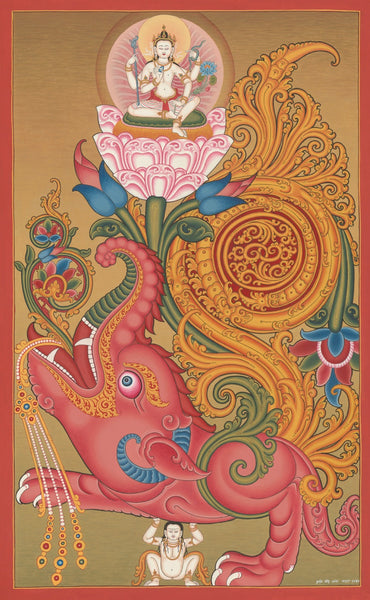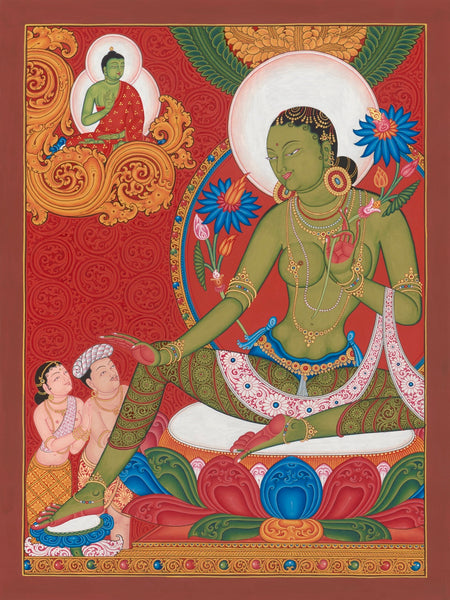Ganesh by Mukti Singh Thapa
$550.00
This mesmerizing work by master artist Mukti Singh Thapa is of the red, twelve-armed, dancing Ganesh. While traditionally a Hindu deity, this depiction of the elephant-headed Ganesh, or Binayak, is from the Sakya School of Tibetan Buddhism. It depicts Ganesh dancing inside a stylized rock cave, framed by an intricate white torana, while standing on a jewel-spitting rat. This spectacular piece displays Thapa's mastery of the 14th - 16th century Newar Design style through its rich color palette, precise lines and scroll patterns, and use of traditional iconography.
This original thangka, or paubha in Nepal, is painted in the traditional manner with ground mineral pigments on primed cotton canvas. Ganesh is painted with rich red cinnabar and the gold ornaments, such as the crown and instruments, are painstakingly painted with 24 carat gold. A painting of this large size will take several months to compose, sketch and complete.
While the original 120 cm (47 inch) artwork has sold, Mahakala Fine Arts has produced an Collector's Edition fine art print so that you can enjoy this museum quality work of art. This piece is limited to 100 prints and can only be found at Mahakala Fine Arts. It is printed on thick archival paper in the same professional quality used by top museums worldwide.
With your 80 cm (31 inch) fine art print you will receive an authentication card, numbered and signed by the artist in English and Nepali script, as well as an artist biography.
Mahakala Fine Arts donates a portion of all print sales to social programs in the Himalaya. Please join us!
If you have any questions, please email Mahakala@MahakalaFineArts.com for more information.
Customer Reviews
Related Items
Newari Amitabha Buddha by Mukti Singh Thapa
$435.00
This work by master artist Mukti Singh Thapa is of Amitabha, the Buddha of Immeasurable Life and Light. This historical painting is part of Mukti Singh Thapa's 'Early Collection' and was completed in 1990. Amitabha symbolizes mercy and wisdom and reigns over Sukhavati, or the Western Pure Land. Eight bodhisattvas are in the background with the white Avalokiteśvara and yellow Manjushree on either side, and five goddesses, Pancha Raksha, on the bottom. This stunning thangka is painted in the Newari style of the 16th century and displays Thapa's mastery of this period through its rich color palette and expert use of traditional iconography.
This original thangka, or paubha in Nepal, is painted in the traditional manner with ground mineral pigments on primed cotton canvas. Here, Amitabha is painting with brilliant red cinnabar. The gold ornaments, such as the crown and jewelry, are painted painstakingly with 24 carat gold. A painting of this size will take several months to compose, sketch and complete.
Although the original painting has sold, Mahakala Fine Arts has produced a Collector's Edition print so that you can collect this museum quality work of art. This piece is limited to 100 prints and can only be found at Mahakala Fine Arts. It is printed on thick archival paper in the same professional quality used by top museums worldwide.
With your 113 cm (44.5 inch), 80 cm (31 inch) or 50 cm (20 inch) prints you will receive an authentication card, signed by the artist in English and Nepali script, as well as an artist biography.
Mahakala Fine Arts donates a portion of all print sales to social programs in the Himalaya. Please join us!
Hitimunga by Mukti Singh Thapa (Original Only)
Price on Request
This dazzling painting by master artist Mukti Singh Thapa is of a Hitimunga, or Makara in Sanskrit. It is part of Mukti's 'Early Collection' and, completed in 1984, one of the oldest pieces we have in the collection. As with all of the artist's work, it is painted in the traditional manner with mineral pigments on cotton canvas. The red body is painted with cinnabar and the jewelry is painted painstakingly with 24 carat gold.
The hitimunga, in Newari, is a mythical animal and is depicted in various ways. Typically, it has the lower jaw of a crocodile, the snout or trunk of an elephant, the tusks and ears of a wild boar, the darting eyes of a monkey, the mane of a horse, the paws of a lion, and the swirling tail feathers of a peacock.
The Newar art of Nepal uses the hitimunga extensively. In addition to appearing often in paubha, or thangka paintings, you will find it frequently in Newar architecture. It is found carved into wood and stone on temples and is often used as a water spout with water coming directly out of its mouth.
The artist has placed Varuna, the God of Water, at the top of the painting, as the hitimunga is his mount. At the bottom is a naga, taking the human form rather than that of a serpent.
The original thangka, or paubha, painting, is available for the astute collector. If you are interested in this original painting, please email Mahakala@MahakalaFineArts.com and we will share the price as well as more information about this unique piece.
Early Green Tara by Mukti Singh Thapa (Original Only)
Price on Request
This lovely painting by master artist Mukti Singh Thapa is of Green Tara, the Buddha of enlightened activity, and is part of Mukti's 'Early Collection.' Tara is the most important goddess in Buddhism and was born from Chenrezig Avalokitesvara's tears of compassion. Green Tara protects practitioners from the eight fears.
Mukti painted this work in the late 1980s or early 90s. It is not dated or signed, as is the custom when painting religious works. This is because the practitioner is worshipping the diety and the artist's signature is a distraction from that focus.
It is very interesting to compare this work to our other Green Tara thangka, painted in 2007. In the late 80s Mukti was starting to design a new style that turned the diety to the side, rather than facing forward, opening the painting and allowing it to tell a story. In this older work, Green Tara is in a meditative pose with two followers, and Amoghasiddhi Buddha in the top left.
As with all of the artist's work, it is painted in the traditional manner with mineral pigments on primed cotton canvas. The green body is painted with malachite and the red background is cinnabar, while the jewelry is painted painstakingly with 24 carat gold.
The original thangka, or paubha in Nepal, painting, is available for the curious collector. If you are interested in this original artwork, please email Mahakala@MahakalaFineArts.com and we will share the price as well as more information about this unique piece.
Standing Mahakala by Mukti Singh Thapa
$550.00
This dazzling painting by master artist Mukti Singh Thapa is of Mahakala, the Protector of the Dharma. It is part of Mukti's 'Early Collection' and was completed in 1988. As with all of the artist's work, it is painted in the traditional manner with mineral pigments on cotton canvas. The stunning blue is painted with lapis lazuli from Afghanistan and the crown and jewelry are painted painstakingly with 24 carat gold.
Mahakala is considered to be the fierce and powerful emanation of Avalokitesvara, the Bodhisattva of Compassion. He defends the Dharma from hostile forces and protects the individual practitioner from deception and delusion, bestowing power to overcome life's struggles. This stunning piece displays Thapa's mastery of the 13th - 16th century Newar Design style through its intricate design, precise lines and use of traditional iconography.
The original thangka, or paubha in Nepal, painting is available for the insightful collector. Additionally, Mahakala Fine Arts has produced a Collector's Edition fine art print so that you can enjoy this museum quality work of art. This piece is limited to 100 prints and can only be found at Mahakala Fine Arts. It is printed on thick archival paper in the same professional quality used by top museums worldwide.
With your 80 cm (31.5 inch) fine art print you will receive an authentication card, numbered and signed by the artist in English and Nepali script, as well as an artist biography.
Mahakala Fine Arts donates a portion of all fine art print sales to social programs in the Himalaya. Please join us!
If you are interested in the original painting, please email Mahakala@MahakalaFineArts.com. Please note that the price ($999,999) on the website is just a placeholder. We will share the price on request as well as more information about this stunning painting.













